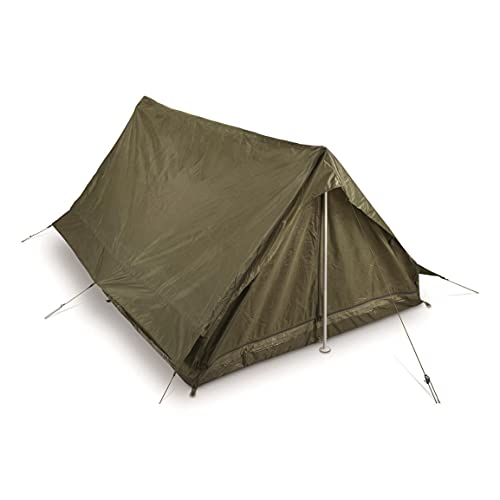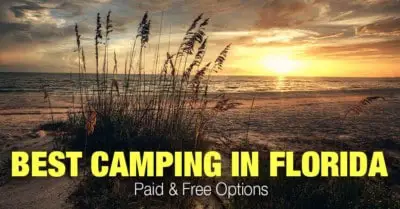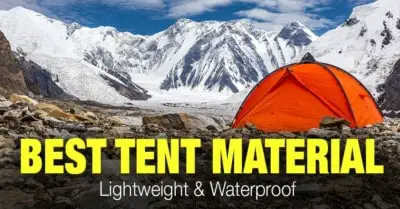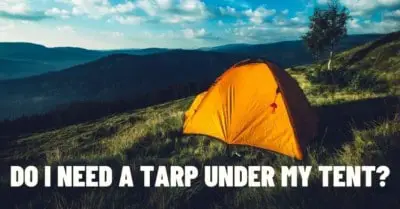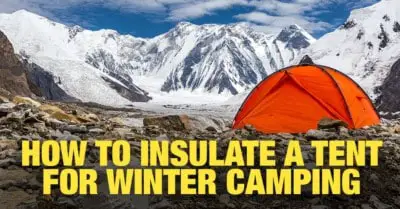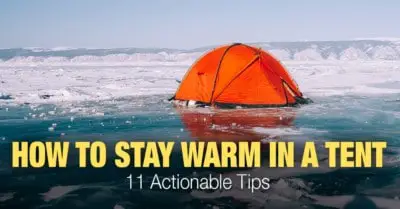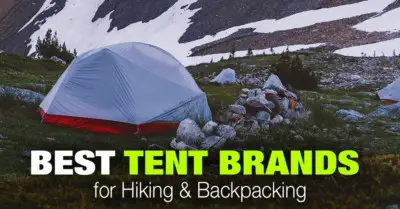Are you overwhelmed by the different types of tents available and struggling to choose the right model for your next camping trip? A few of them may be familiar to you, but not all. You never had any idea there were so many tent varieties!
What are the different tent types?
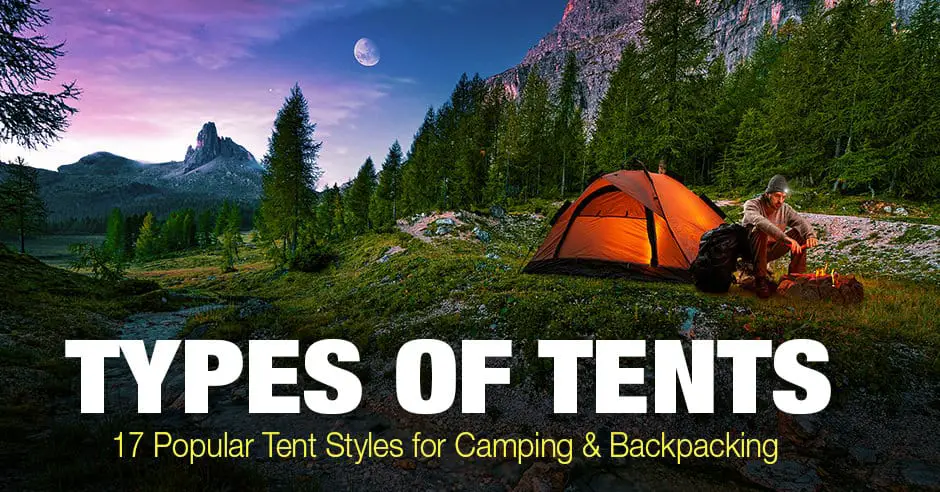
The types of tents include the following:
- Tunnel tents
- Rooftop tents
- Ridge tents
- Pop-up tents
- Inflatable or air tents
- Canopy tents
- Geodesic or semi-geodesic tents
- Tipi tents
- Backpacking tents
- Dome tents
- Multi-room tents
- Suspended tents
- Beach tents
- Bell tents
- Bivy tents
- Pyramid tents
- Cabin tents
We’re sure you’re curious to learn more about each of these 17 tent types. If so, then you’ve come to the right place. Ahead, we’ll discuss every type of tent on the above list in great detail, including the intended tent uses, benefits, and downsides. You’re not going to want to miss it!
The 17 Different Types of Tents
1. Tunnel Tents
The first type of tent you might consider is a tunnel tent. The poles of a tunnel tent are curved in such a way that the tent itself creates a tunnel-like structure. The breathing room you get in a tent shaped like this makes camping enjoyable, not to mention you have the capacity to bring more friends and family with you.
Intended Use: Family camping
Benefits
- Tunnel tents are heavy, so they’re sure to stay where you put them.
- You can set up your tunnel tent, so it’s facing the wind without the tent being knocked down.
- These tents have lots of room for gear or more people.
- You get a great overhead room for taller campers in a tunnel tent.
Downsides
- Heavy side winds can knock your tunnel tent down or collapse it.
- Ventilation can be limited in the center of the tent, which will make you want to avoid using this area.
- If you’re in a tightly-packed campsite or a small space, you likely won’t have much room for your tent.
2. Rooftop Tents
The second type of tent is the rooftop tent. As the name suggests, this tent is sized to the rooftop of an SUV or 4×4. Although much smaller than your average tent, some sizable rooftop tents can fit up to four people at once, which is pretty cool! You will need a ladder to access your rooftop tent.
Intended Use: Car camping
Benefits
- Camping from your SUV or truck is possible with a rooftop tent.
- These tents are bigger than they appear, giving you room for four people max.
- Rooftop tents pop right up and can be compressed quickly when not in use.
- Most rooftop tents include mesh doors and windows.
Downsides
- Sleeping on the top of your vehicle might not always be comfortable, so you’ll need thicker bedding in this tent.
- You really have to take the time to secure a rooftop tent, or it will easily blow away.
- Having to get in and out of the tent via an access ladder can be time-consuming.
3. Ridge Tents
The old classic known as the ridge tent was a preferred choice for decades. Even though it’s less favorable these days, don’t disqualify the ridge tent. It’s still a very viable option.
Despite their name, ridge tents are triangular in shape, and they come in all sorts of sizes. If you want a cozier camping experience with only you and a friend or partner, you can get a ridge tent for two. Some ridge tents can also accommodate three or four people or more.
Intended Use: Family camping and hiking
Benefits
- Ridge tents are quite durable, so it’s hard for the wind to knock them down.
- Setup is quick and easy, so even beginners can feel confident in their camping skills.
- The size options mean you can buy a ridge tent that fits your camping needs.
- Included guy ropes add to the strength of a ridge tent.
Downsides
- The sides and top of the tent don’t provide much headroom, precluding other activities besides sleeping.
- Ridge tents are heavier than some other tents, so carrying them around can be a pain.
- You lack storage space over other types of more modern tents.
4. Pop-up Tents
If you want your tent set up quickly, then you’ll certainly like the pop-up tent. As soon as you open the tent, it takes its shape, and voila, you have a tent ready without any hard work. You can bring another camper with you and have decent space apiece in your pop-up tent.
Intended Use: Family camping, car camping
Benefits
- Even more so than ridge tents, a pop-up tent creates confidence in new campers since this tent sets up in moments. You only have to tie down the tent.
- Carrying and transporting this tent is no big deal since it’s lightweight and thin.
- You get more room in a pop-up tent than you’d think looking at it from the outside.
- If you need to camp in a smaller area, a pop-up tent is an ideal pick.
Downsides
- If you’re doing backcountry camping or camping out in the deep wilderness, skip the pop-up tent. It can’t handle the rigors of these types of camping.
- You don’t have a lot of headroom in this tent.
- High winds can easily blow your pop-up tent away, so be careful!
5. Inflatable/Air Tents
The inflatable tent, also known as the air tent, is a relative newcomer and thus some of the latest in tent technology. Completely pole-less, inflatable tents include panels throughout that are hollow. You fill those panels with air using a pump, add a few tent pegs on the guy lines, and your tent is up and running.
Intended Use: Family camping, car camping
Benefits
- Air tents are quite sizable, enough so that you should be able to fit storage and some passengers inside. You also get good headroom.
- You can skip the poles and still set up an air tent quickly, so these tents are another suitable choice for beginner campers.
- You erect an air tent by yourself if you needed to.
- Although they’re only filled with air, inflatable tents have some weight when inflated.
Downsides
- You have to bring a pump with you when camping, or an air tent is useless.
- Air tents may be costlier than other tent types since they’re new.
- You have to be careful where you put your tent, so it doesn’t get punctured.
6. Canopy Tents
Although unsuitable for every day and overnight camping, a canopy tent is a convenient tent to use if you need protection from the hot sun or a sudden rainstorm. Everyone crowds under the tent, which provides moderate headroom and sometimes open sides.
Intended Use: Car camping, family camping
Benefits
- Canopy tents can be set up in moments, so you can use them in a pinch.
- The stakes and guy lines of the tent are sturdy to withstand the wind and inclement weather.
- Most canopy tents are waterproof.
- The side panels typically come out for more roominess if your tent has them.
Downsides
- This tent is not suitable for overnight camping or even long-term daytime camping.
- Canopy tents are also ineligible to be your main tent, so you’d have to bring twice the tent materials when camping.
- You get no side protection with most canopy tent styles.
7. Geodesic/Semi-Geodesic Tents
This next type of tent is like two in one: geodesic and semi-geodesic tents. What does geodesic mean? Something that is geodesic refers to that which has the shortest line from one point on a sphere to the other.
That should tell you that geodesic and semi-geodesic tents are curved like a dome. Geodesic tents have several poles that crisscross each other for weather durability. Semi-geodesic tents reduce the number of poles, so this tent weighs less.
Intended Use: Family camping
Benefits
- You can select from a variety of geodesic or semi-geodesic tent sizes.
- The durability of geodesic tents especially is enough to withstand wind and inclement weather.
- Most geodesic tents feature tall ceilings and great headroom.
- Geodesic and semi-geodesic tents tend to boast quite a long lifespan among the different tent types.
Downsides
- Although not as much of an issue with semi-geodesic tents, geodesic tents can be quite heavy.
- You do typically have a more restrictive limit on campers in these tents than other types.
- Geodesic and semi-geodesic tents are often pretty expensive.
8. Tipi Tents
Whether you spell it tipi or tee-pee, these tents have a very distinct triangular shape that makes them much beloved. Some models can comfortably accommodate up to 10 people, although most tipi tents have room for two to five campers.
Intended Use: Family camping
Benefits
- This is one of the bigger camping tents around due to how the top is narrow, but the bottom of the tent tapers out.
- The included stakes and guy lines make a tipi quite sturdy, so it can handle some winds and even rain.
- Top ventilation could theoretically let you use a wood stove flue pipe in your tent if you really wanted to.
- The classic style of this tent is a timeless favorite.
Downsides
- Tipi tents are heavy, so moving them isn’t always easy.
- A central pole does limit some of the room you have in this tent.
- Some tipis have no flooring, leaving it on you to provide it.
9. Backpacking Tents
A lower and narrower tent, backpacking tents are made for durability and portability. Intended for backpackers and hikers looking to stay the night out in nature without carrying a big, heavy tent, backpacking tents can fit up to two people max.
Intended Use: Hiking, backpacking
Benefits
- Backpacking tents don’t weigh a lot, and they are set up easily so you can erect them where your outdoor travels take you.
- These tents can compress and fold up so you can stash them in your backpack and be on your way.
- Mesh panels in some areas of the tent increase the ventilation of a backpacking tent.
- With a limited number of poles, you can easily control this tent’s weight.
Downsides
- A backpacking tent has a design that puts it lower to the ground. These tents are also fairly narrow.
- You can only fit two people at most.
- You’re lacking significant overhead room.
10. Dome Tents
In the same vein as a geodesic and semi-geodesic tent is the dome tent. These spherical tents feature dual crisscrossing poles that meet in the middle of the tent. This delivers a higher center point compared to other tent types, so you’re not lacking in the headspace. Water also slides right off the top of this tent due to its design.
Intended Use: Family camping
Benefits
- Setting up a dome tent is easy.
- A top rainfly at each pole keeps your tent drier from rain and other inclement weather.
- Rain slides right off this domed tent, rolling to the ground.
- Some more advanced models have a small mudroom for keeping your dirty gear.
Downsides
- Dome tents don’t come in many sizes, limiting you on how many people you could bring.
- If a strong wind comes through, your tent might be toppled.
- A mudroom vestibule is not guaranteed.
11. Multi-Room Tents
If you do indeed want a guaranteed vestibule, then look into a multi-room tent. This spacious tent can easily fit eight or 10 people across its four segments or areas. Each group would have some privacy, which is something you don’t often find in a tent. Adding to the appeal of a multi-room tent is the tunnel-like style.
Intended Use: Family camping
Benefits
- Internal dividers within the tent add further to your sense of privacy.
- With at least four doors, you have several ways to get into and out of a multi-room tent.
- You can freely stand in a tent like this and still have headroom, which is nice.
- Bigger groups will not feel cramped or on top of each other.
Downsides
- Given its size, setting up a multi-room tent is time-consuming and can be difficult. You’ll likely need a second person to help you get the tent tied down.
- These tents also tend to be expensive given how big they are.
- Toting around a multi-room tent is not very easy due to the tent’s weight.
12. Suspended Tents
Suspended tents are much smaller than multi-room tents and even tight in space compared to your average tent. Narrow and streamlined, a suspended tent–as the name suggests–is supposed to be suspended up into the treetops or high over a summit. Not for all types of campers by far, if you want to take your camping experience up a notch, try a suspended tent.
Intended Use: Hiking
Benefits
- Experienced campers can gain a whole new appreciation for camping when using a suspended tent.
- Most suspended tents can hold upwards of 400 pounds or about four people.
- Mesh doors let you appreciate the views of the outside world.
- The suspension straps are thick and durable, so you can feel safe in your tent.
Downsides
- You’re suspended in one of these tents, which is not something every camper will like.
- You don’t get as many campers as you do with other types of tents.
- Although suspended tents are thin, they weigh more than you would think.
13. Beach Tents
If you’re going to park on the beach for a while and sleep while the waves lull you off to dreamland, then you need a beach tent. These geodesic or dome-style tents often include UV protection, so you’re safe from the sun’s burning rays even when you’re in the tent. With mesh windows, you can still watch the waves but remain sheltered.
Intended Use: Family camping
Benefits
- Beach tents are made for beach fun and can prevent sand from getting in uncomfortable places. You’re also safeguarded from sunburn.
- These tents include sand pockets so you can easily set up your stakes in the sand.
- An included floor gives you a comfortable place to sit.
- You can fit up to six people in a beach tent.
Downsides
- These tents are thin and lightweight and might not be able to handle stronger winds.
- You may have to keep the mesh windows open at times to prevent the tent from getting hot.
- Beach tents have a lot of poles, which can complicate the setup.
14. Bell Tents
Have you ever heard of glamping or glamorous camping? Now you too can do that in a bell tent. The canvas base of a bell tent adds to its appeal, and some tents even have wood-burning stove openings like the tipi tent we discussed earlier.
Intended Use: Daytime camping
Benefits
- Most bell tents are set up the same way as a tipi tent.
- The canvas can insulate your temperature, keeping the inside of the tent quite comfortable.
- Bell tents certainly make a statement, especially if you get a patterned one.
- You could have the capability of adding a wood-burning stove, which is pretty cool.
Downsides
- Bell tents are not made for roughing it in nature.
- The center pole, as found in a tipi tent, is back in a bell tent, limiting how much room is inside.
- These are some of the most expensive tents around.
15. Bivy Tents
A single-person tent and bivy tents are similar to backpacking tents in that they’re made for those roughing it who need a place to stay. These tents are set up quickly, and some models even have a bug net built in. The ventilation of bivy tents is another standout feature.
Intended Use: Hiking
Benefits
- Bivy tents are very easily compressed and stored in your bag without weighing you down.
- The assembly of a bivy tent is simple so you don’t have to spend too much time or energy getting ready for the night.
- The ventilation within a bivy tent makes it easy to breathe even if the tent is all closed up.
- Bug nets will keep you insect-free all night.
Downsides
- You can only fit one person in a bivy tent.
- The shape is sort of coffin-like, which might be offsetting to some campers.
- Bivy tents stay low to the ground and are quite narrow, leaving you with next to no headroom.
16. Pyramid Tents
A pyramid tent has a less tapered shape than a tipi but is otherwise quite similar. You have the middle pole as well as stakes at the edges or corners of the tent. Some pyramid tents also feature a top rainfly.
No products found.
Intended Use: Family camping
Benefits
- Older pyramid tents were heavy, but you can find lighter-weight ones these days if that’s what you need.
- Setting up a pyramid tent is fast and not very difficult.
- If you pitch your pyramid tent the right way, you don’t have to stress about inclement weather.
- The rainfly will promote more dryness in your tent.
Downsides
- Bigger pyramid tents may be more unstable than their smaller counterparts.
- If you stake your tent incorrectly, it might not be as stable as it could be.
- You’ll have to provide your own groundsheet for many types of pyramid tents.
17. Cabin Tents
The last type of tent we’ll discuss is the cabin tent. These tents feature poles made of lightweight aluminum to build a cabin-like frame. A rainfly may be made of canvas, nylon, or polyester and is always waterproof. Internal dividers, much like in a multi-room tent, can create more privacy when camping.
Intended Use: Family camping
Benefits
- Cabin tents are the next best thing to staying somewhere with a roof over your head, and you still get the authentic camping experience.
- You have enough headroom where many people can comfortably stand.
- You can easily fit at least 10 campers, so bring your friends or family.
- Cabin tents are cheaper than they’d seem.
Downsides
- Some are too cheap and can fall apart easily.
- Setting up a cabin tent is not easy.
- These tents weigh quite a lot.
Things to Consider When Selecting a Tent
We just introduced more than a dozen types of camping tents. You might have narrowed down your options to a handful of tents you’re interested in, but how do you select the one that’s right for you? Keep the following factors in mind!
Price
No matter your tent budget, there’s surely a tent out there that fits your spending limit. Do make sure that no matter which type of tent you buy that it’s not overly cheap. Cutting corners like this could leave you with no protection from nature if the weather starts getting bad!
Material
In this guide, we talked about tents made of nylon, canvas, and a bevy of other materials. Depending on what you value in a tent, some materials will be more attractive to you than others.
See also: Are Propane Heaters Safe In A Tent?
For example, canvas is a great insulator, but it won’t do anything to prevent the effects of UV rays. Nylon is lightweight for breathability, which is handy but doesn’t insulate. Once you think about how you want to use your tent, you’ll naturally gravitate towards a tent material.
Intended Use
Do you plan on sprawling out at the beach and catching some rays? Then you need a beach tent. Perhaps you want to camp atop your vehicle, in which case, a rooftop tent is best. Try a pop-up or an inflatable tent if you need a quick setup. For glamping, you’re better off with a bell tent.
Capacity
Another important factor to consider is how many people you intend to bring with you. If it’s just you or another person, then a backpacking tent, suspended tent, or bivy tent works well. Most of the other tents we discussed can fit at least four people, which is the size of a standard family.
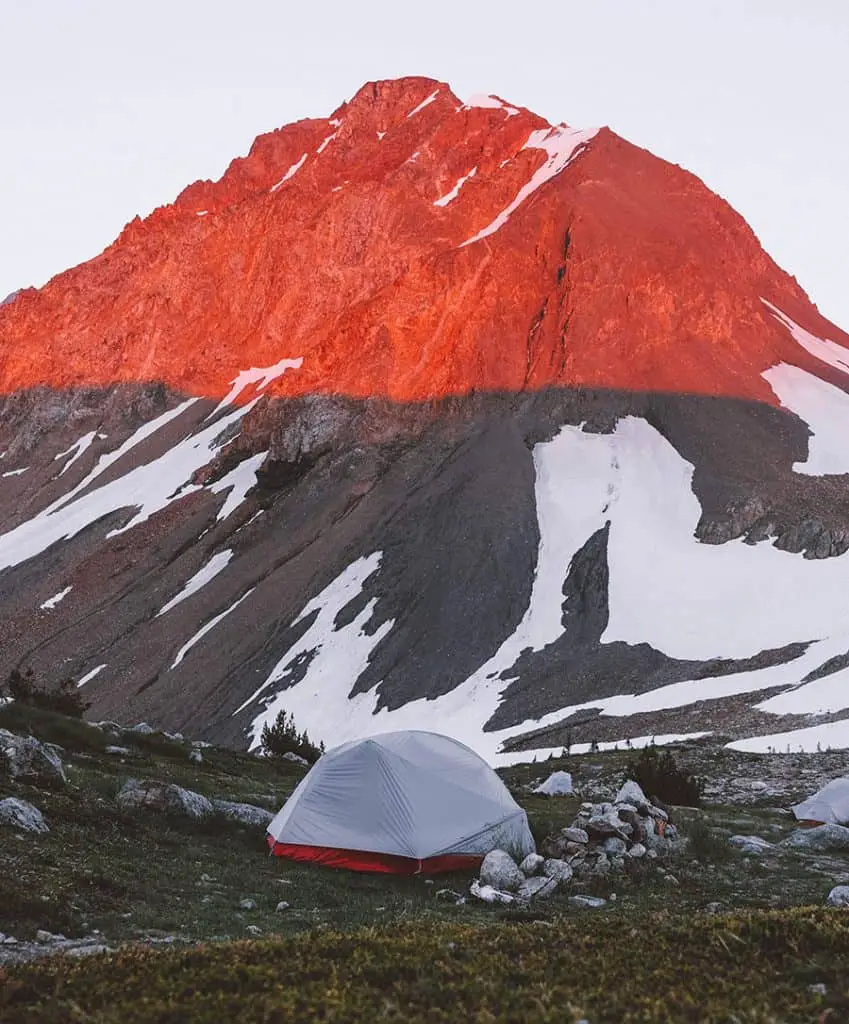
Do keep in mind that for bigger groups, you need an equally sizable tent. Your options include a multi-room tent, bell tent, or cabin tent.
Ease of Setup
Almost every tent covered in this guide should be set up relatively simply, but some have more poles or require further tying down, which complicates the process. Since you’re new to camping, don’t make the experience harder by purchasing a tent with too many bells and whistles. Keep it easy for now!
Ventilation
Ventilation in the form of mesh panels, windows, or doors is important in any tent. Without ventilation, you’ll find yourself overheating quickly. This is okay if it’s a cold night, but you don’t want to wake up drenched in sweat in the summertime.

Height
If you’re just using your tent for sleeping, then the tent height might not be such a big concern. If you plan on chilling out and relaxing by day in your tent, though, you must ensure it has the headroom for you to sit up or even stand up without your head colliding with the ceiling.
Types of Tents | Conclusion
Tents come in all shapes, sizes, and materials to accommodate a variety of needs. Whether you’re a solo traveler who’s roughing it, someone who prefers glamping, or just an everyday, regular camper, there’s a tent for you. Now you know how to find one!



